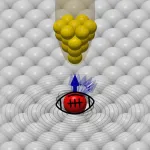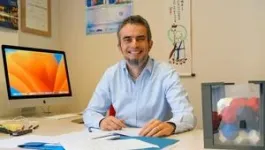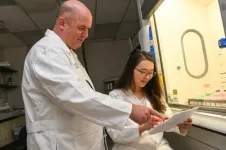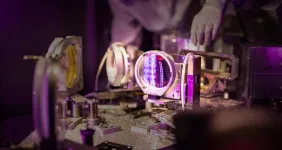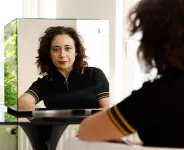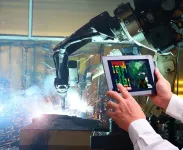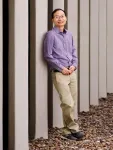(Press-News.org) Extreme conditions prevail in the Würzburg laboratory of experimental physicists Professor Matthias Bode and Dr. Artem Odobesko. Affiliated with the Cluster of Excellence ct.qmat, a collaboration between JMU Würzburg and TU Dresden, these visionaries are setting new milestones in quantum research. Their latest endeavor is unveiling the spinaron effect. They strategically placed individual cobalt atoms onto a copper surface, brought the temperature down to 1.4 Kelvin (–271.75° Celsius), and then subjected them to a powerful external magnetic field. “The magnet we use costs half a million euros. It’s not something that’s widely available,” explains Bode. Their subsequent analysis yielded unexpected revelations.
Tiny Atom, Massive Effect
“We can see the individual cobalt atoms by usinga scanning tunneling microscope. Each atom has a spin, which can be thought of as a magnetic north or south pole. Measuring it was crucial to our surprising discoveries,” explains Bode. “We vapor-deposited a magnetic cobalt atom onto a non-magnetic copper base, causing the atom to interact with the copper’s electrons. Researching such correlation effects within quantum materials is at the heart of ct.qmat’s mission – a pursuit that promises transformative tech innovations down the road.
Like a Rugby in a Ball Pit
Since the 1960s, solid-state physicists have assumed that the interaction between cobalt and copper can be explained by the Kondo effect, with the different magnetic orientations of the cobalt atom and copper electrons canceling each other out. This leads to a state in which the copper electrons are bound to the cobalt atom, forming what’s termed a “Kondo cloud.” However, Bode and his team delved deeper in their laboratory. And they validated an alternate theory proposed in 2020 by theorist Samir Lounis from research institute Forschungszentrum Jülich.
By harnessing the power of an intense external magnetic field and using an iron tip in the scanning tunneling microscope, the Würzburg physicists managed to determine the magnetic orientation of the cobalt’s spin. This spin isn’t rigid, but switches permanently back and forth, i.e. from “spin-up” (positive) to “spin-down” (negative), and vice versa. This switching excites the copper electrons, a phenomenon called the spinaron effect. Bode elucidates it with a vivid analogy: “Because of the constant change in spin alignment, the state of the cobalt atom can be compared to a rugby ball. When a rugby ball spins continuously in a ball pit, the surrounding balls are displaced in a wave-like manner. That’s precisely what we observed – the copper electrons started oscillating in response and bonded with the cobalt atom.” Bode continues: “This combination of the cobalt atom’s changing magnetization and the copper electrons bound to it is the spinaron predicted by our Jülich colleague.”
The first experimental validation of the spinaron effect, courtesy of the Würzburg team, casts doubt on the Kondo effect. Until now, it was considered the universal model to explain the interaction between magnetic atoms and electrons in quantum materials such as the cobalt-copper duo. Bode quips: “Time to pencil in a significant asterisk in those physics textbooks!”
Spinaron and Spintronics
In the spinaron effect, the cobalt atom remains in perpetual motion, maintaining its magnetic essence despite its interaction with the electrons. In the Kondo effect, on the other hand, the magnetic moment is neutralized by its the electron interactions. “Our discovery is important for understanding the physics of magnetic moments on metal surfaces,” declares Bode. Peeking into the future, such phenomena could pave the way for magnetic information encoding and transportation in new types of electronic devices. Dubbed “spintronics,” this could make IT greener and more energy-efficient.
However, Bode tempers expectations when talking about the practicality of this cobalt-copper combination. “We’ve essentially manipulated individual atoms at ultra-low temperatures on a pristine surface in ultra-high vacuum. That’s infeasible for cell phones. While the correlation effect is a watershed moment in fundamental research for understanding the behavior of matter, I can’t build an actual switch from it.”
Currently, Würzburg quantum physicist Artem Odobesko and Jülich theorist Samir Lounis are concentrating on a large-scale review of the numerous publications that have described the Kondo effect in various combinations of materials since the 1960s. “We suspect that many might actually be describing the spinaron effect,” says Odobesko, adding: “If so, we’ll rewrite the history of theoretical quantum physics.”
Cluster of Excellence ct.qmat
The Cluster of Excellence ct.qmat – Complexity and Topology in Quantum Matter has been jointly run by Julius-Maximilians-Universität Würzburg and Technische Universität Dresden since 2019. Nearly 400 scientists from more than thirty countries and four continents study topological quantum materials that reveal surprising phenomena under extreme conditions such as ultra-low temperatures, high pressure, or strong magnetic fields. ct.qmat is funded through the German Excellence Strategy of the Federal and State Governments and is the only Cluster of Excellence in Germany to be based in two different federal states.
END
New quantum effect demonstrated for the first time: Spinaron, a rugby in a ball pit
2023-10-26
ELSE PRESS RELEASES FROM THIS DATE:
Researchers identify amino acid that may play a key role for predicting and treating long COVID
2023-10-26
University of Alberta researchers have identified an amino acid that may play a key role in predicting poor clinical outcomes and the treatment of long COVID.
In research published today in Cell Reports Medicine, the team says it has developed a predictive test to determine which patients with COVID-19 will go on to develop longer-term symptoms and proposes a clinical trial of an already-approved supplement as a potential treatment.
“This research helps us understand what’s happening in the bodies of people ...
UTHealth Houston researchers awarded $3.4M NIH grant to study pharmaceutical therapies to treat acute respiratory distress syndrome
2023-10-26
A four-year, $3.4 million grant to investigate molecular mechanisms and therapeutic treatments for acute respiratory distress syndrome (ARDS) has been awarded to UTHealth Houston researchers by the National Heart, Lung, and Blood Institute, part of the National Institutes of Health.
The study led by principal investigators Holger Eltzschig, MD, PhD, professor and chair of the Department of Anesthesiology, Critical Care and Pain Medicine at McGovern Medical School at UTHealth Houston, and Xiaoyi Yuan, PhD, assistant professor in the department, is built on many years of research in the endogenous ...
Renewed support for high power laser facilities will benefit discovery science and inertial fusion energy research at SLAC
2023-10-26
Research and technology development for plasma physics and fusion energy at the Department of Energy’s SLAC National Accelerator Laboratory just got a boost from a LaserNetUS award.
In total, the DOE’s Office of Science awarded $28.5 million to advance discovery science and inertial fusion energy, including a three-year grant for the development and operations of the Matter in Extreme Conditions (MEC) instrument at SLAC’s Linac Coherent Light Source (LCLS).
MEC has been home to high intensity laser experiments since 2012, and joined ...
TUM professor develops energy-saving AI chip
2023-10-26
The basic idea is simple: unlike previous chips, where only calculations were carried out on transistors, they are now the location of data storage as well. That saves time and energy. “As a result, the performance of the chips is also boosted,” says Hussam Amrouch, a professor of AI processor design at the Technical University of Munich (TUM). The transistors on which he performs calculations and stores data measure just 28 nanometers, with millions of them placed on each of the new AI chips. The chips of the future will have to be faster and more efficient than earlier ones. Consequently, ...
SETI Institute artist-in-residence Daniela De Paulis to receive 2023 Europlanet Prize for Public Engagement
2023-10-26
SETI Institute Artist-in-Residence Daniela De Paulis to Receive 2023 Europlanet Prize for Public Engagement
Daniela de Paulis is honored for her work bringing space and planetary science to international audiences.
October 26, 2023, Mountain View, CA -- The SETI Institute is thrilled to announce that Daniela De Paulis, a SETI Artist-in-Residence (SETI AIR), will be honored with the prestigious 2023 Europlanet Prize for Public Engagement. De Paulis’ groundbreaking project, ‘A Sign in Space,’ invited a global audience to participate in decoding a simulated message from an extraterrestrial ...
Genomic screening to identify iron overload encourages patients to seek treatment and condition management, study finds
2023-10-26
DANVILLE, Pa. – Genomic screening to identify hemochromatosis—a disorder that causes iron levels in the body to rise to dangerous levels—encourages people with the condition to seek treatment and ongoing management, a Geisinger study found.
Hereditary hemochromatosis type 1 (HH1), caused by a change in the HFE gene, is underdiagnosed, often resulting in missed opportunities for early and consistent treatment. Without treatment, hemochromatosis can cause iron overload, a buildup of iron that can damage many parts of the body. Treatment of hemochromatosis includes regular monitoring of iron levels and removing excess iron ...
People with autism less likely to succumb to bystander effect, York University father-son research duo finds
2023-10-26
People with autism less likely to succumb to bystander effect, York U father-son research duo finds
Schulich School of Business and Faculty of Health researchers say that while as many as 90 per cent of people with autism are unemployed or underemployed, their study points to the benefits of having neurodivergent people in the workplace
TORONTO, Oct. 26, 2023 — A well-established psychological theory states that most of us are less likely to intervene in a bad situation if other people are present, and this ‘bystander effect’ also applies to workplace settings. However, new research led ...
UTSA receives $500,000 US Economic Development Administration grant to build secure manufacturing hub in South Texas
2023-10-26
(San Antonio, October 26, 2023) -- The Cybersecurity Manufacturing Innovation Institute (CyManII) at The University of Texas at San Antonio (UTSA) has been selected by the U.S. Economic Development Administration (EDA) to establish an ecosystem that will promote secure manufacturing strategies across South Texas. The Secure Manufacturing in South Texas Strategy Development Consortium, funded by a $500,000 Tech Hubs Strategy Development Grant, will enable CyManII to take initial steps to develop a Secure Manufacturing Tech Hub that will mature technologies, enhance business competitiveness ...
Asian American Engineer of the Year goes to Sandia Labs computer scientist
2023-10-26
ALBUQUERQUE, N.M. — Tian Ma, a distinguished computer engineer in research and development at Sandia National Laboratories, has been honored as a 2023 Asian American Engineer of the Year by the Chinese Institute of Engineers-USA. Each year, CIE recognizes exceptional Asian American engineers who demonstrate strong technical skills, leadership abilities and a commitment to public service. Previous recipients of this award include Nobel laureates and astronauts.
Ma’s expertise in data analysis and processing has propelled him to national recognition as an expert in detection algorithms and tracking systems. His journey ...
Venus had Earth-like plate tectonics billions of years ago, study suggests
2023-10-26
PROVIDENCE, R.I. [Brown University] — Venus, a scorching wasteland of a planet according to scientists, may have once had tectonic plate movements similar to those believed to have occurred on early Earth, a new study found. The finding sets up tantalizing scenarios regarding the possibility of early life on Venus, its evolutionary past and the history of the solar system.
Writing in Nature Astronomy, a team of scientists led by Brown University researchers describes using atmospheric data from Venus and computer modeling to show that the composition of the planet’s current atmosphere and surface pressure would only have been possible as a result of an early form of plate ...
